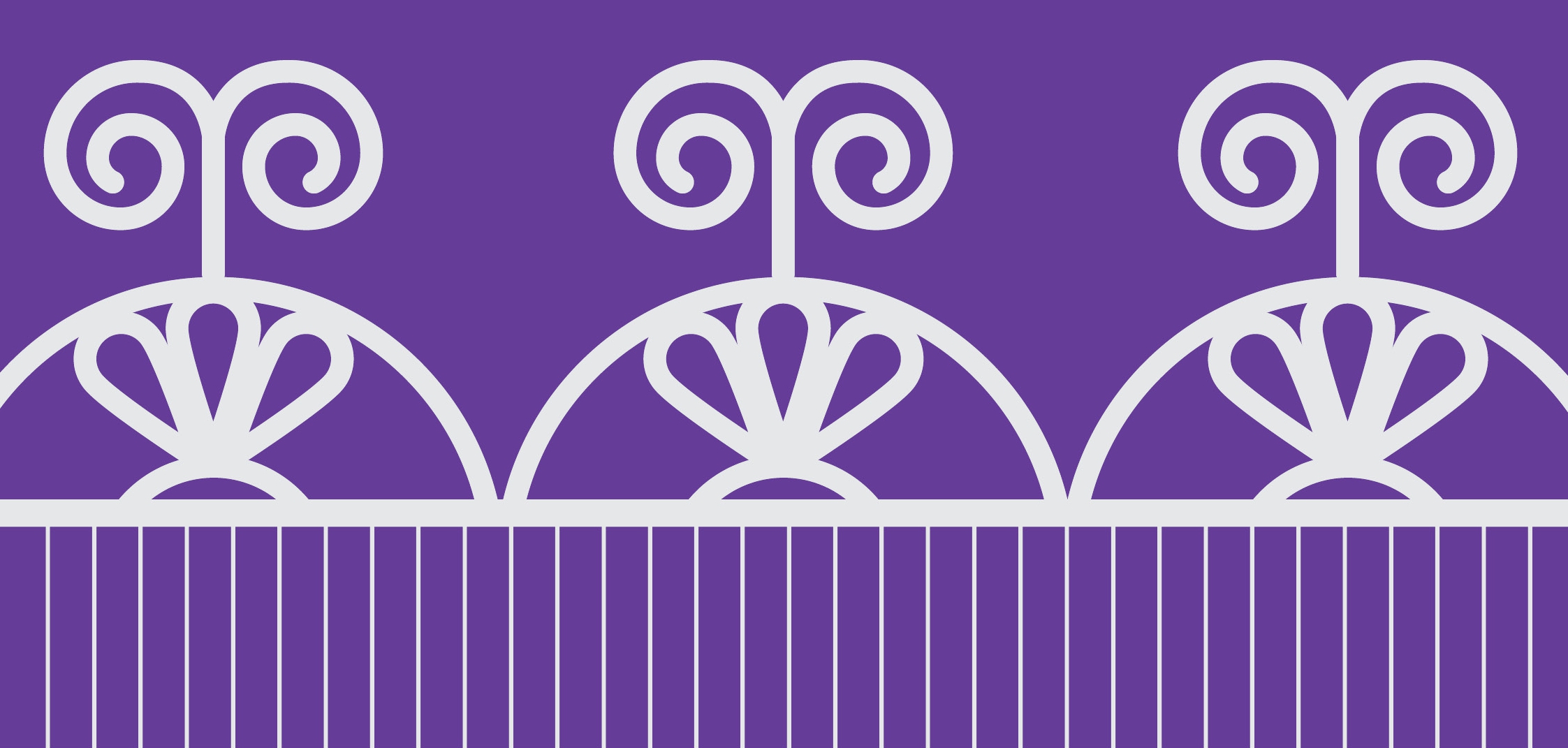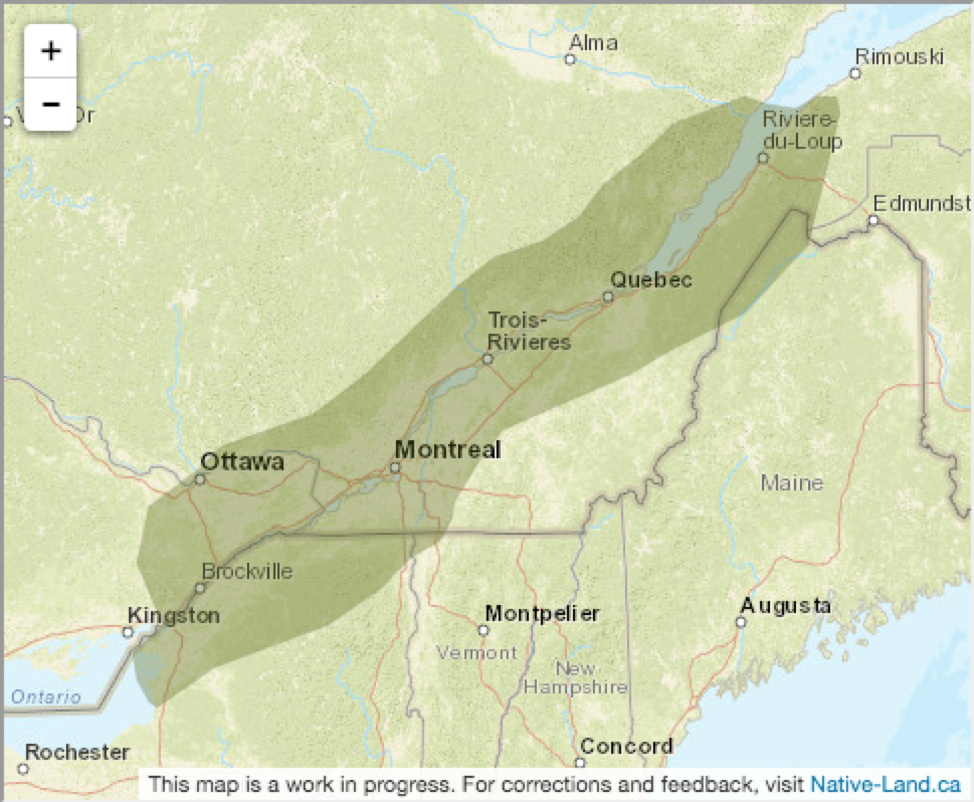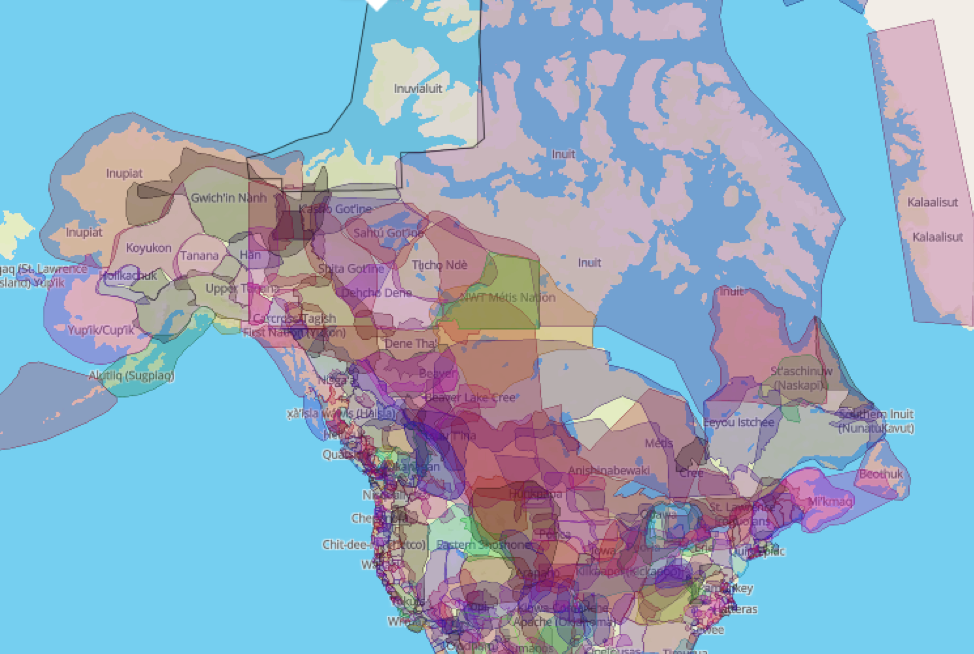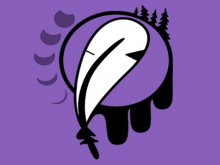






The un-ceded lands where McGill University is located hold a long and rich history of occupation and stewardship by Indigenous peoples for millennia through to the present day. Recognizing and respecting the presence of these historical and contemporary communities, and their unending connection to and care of this land, is an important step towards building trust and creating or renewing relationships.
The Haudenosaunee and Anishinaabeg peoples have long ties to what is now the Island of Montreal. Kawenote Teiontiakon is a documented Kanien’kéha name for the Island of Montreal. The City of Montreal is known as Tiohtià:ke in Kanien’kéha, and Mooniyang in Anishinaabemowin. McGill University is located closest to the Kanien'kehá:ka Nation communities at Kahnawá:ke, Kanehsatà:ke and Akwesasne. The Kanien'kehá:ka Nation is a founding nation of the Haudenosaunee/People of the Longhouse (Iroquois) Confederacy which is also comprised of the Seneca, Tuscarora, Cayuga, Onondaga, and Oneida Nations. The Hochelaga Monument on McGill’s Lower Campus Field commemorates the Iroquoian village of Hochelaga visited by Jacques Cartier in 1535, which was situated in the area around Mont Royal. Beyond the Downtown and Macdonald campuses on the Island of Montreal, McGill University also features four research stations in addition to the newly opened Campus Outaouais in Gatineau, Quebec.
What are the Indigenous lands upon which McGill University is situated?
Kanien’kehá:ka Territory: Downtown and Macdonald Campuses, Island of Montreal
Anishinabeg Territory: Campus Outaouais, Gatineau, Quebec
Abenaki Territory: Gault Nature Reserve on Mount Saint Hillaire, Quebec
Naskapi and Innu Territory: McGill Sub-Arctic Research Station in Schefferville, Quebec
Inuit Territory: McGill Artic Research Station on Grise Fiord Inuit-owned land, Nunavut
Taino (Arawak) and Kalinago (Carib) Territory: McGill Tropical Bellaires Research Station, Barbados
Land Acknowledgements
Land acknowledgements are one way of acknowledging the presence of Indigenous nations. Another important step towards reconciliation is learning about the particular communities and nations with ties to Tiohtià:ke/ Montreal.
Land Acknowledgement Guides
How to Make a Land Acknowledgement - McGill
External Guides to Land Acknowledgements
- Canadian Association of University Teachers - Guide to Acknowledging First Peoples and Traditional Territory
- Concordia University- History, rationale, pronounciation guide, and FAQ of territorial acknowledgement
- Native Governance Center - A Guide to Indigenous Land Acknowledgment
Pronunciation Guide
Name Phonetic Pronunciation Kanien’kehá:ka
Haudenosaunee
Tiohtià:ke
Anishinabeg
Ga-niyen-ge-HAA-ga
Hoh-DEE-noh-SHoh-nee
Joh-jaw-gay
Ah-nish-ih-nah’-bey
Listen to pronounciations:
- Ahkwesáhsne
- Anishinaabeg
- Haudenosaunee canon Rotinonshonni - The Iroquois League
haudenosaunee_canon_rotinonshonni_.mp3
- Io - You're welcome
- Ionkhhisotho:kon Ratiwe:ras - Grandfather, the thunderers
ionkhhisotho_kon_ratiwe_ras_.mp3
- Ionkhi'nistenha tsi iohonsta:te - Our mother the earth
ionkhinistenha_tai_iohonsta_te_.mp3
- Ionkhihsotha Ahsonthenhnehkha Karahkwa - Grandmother, the nighttime moon
ionkhhisotho_kon_ratiwe_ras_.mp3
- Iotsistohkwaronion tsi tkaronhia:te - The stars in the sky
iotsistohkwaronion_tai_tkaronhia_te_.mp3
- Kahihshon:a - The fruits
- Kahnawà:ke
- Kahnekaronnion - The waters
- Kaienthohsera/Tionhnhehkwen - Our sustenance (Kaienthóhsera, ó:ni’ ne Tionhnhéhkwen – Ó:nenhste, Osahè:ta, tánon Onon’ónsera)
kaienthohsera_tionhnhehkwen_.mp3
- Kaieri Nikawere:ke - Four winds
- Kaion'kehá:ka - People of the swamp
- Kanehsatà:ke
- Kanien’keha:ka - People of the flint, Mohawk
- Katerihwaiénstha ni ní:'I Ohni - I'm a student, too
katerihwaiensta_ni_ni_i_ohni_.mp3
- Katewienstonhatie - I am a student
- Kentson’shon:a - The fish life
- Kontirio - Wild animals
- Kwe - Hi
- KweKwe - Hi there
- Niá:wen - Thank you
- Niá:wen ki' wáhi - Thanks a lot (thank you my good friend, it's dearer to the heart)
- Nia:wenkowa
- Ó:nen - Bye
- Ó:nen ki' wáhi - Goodbye (goodbye my good friend)
- Ohenton Karihwatehkwen - Words before all else/thanksgiving address
- Ohonte’shon:a tanon Ohtehra’shon:a - The plant life and the roots
ohonteshon_a_canon_ohtehrashon_a_.mp3
- Ohswé:ken
- Okwire'shon:a - The trunks and the trees
- Onenio’te’á:ka - People of the standing stone
- Onkwehshon:a - The people
- Ononhkwa’shon:a - The medicines
- Ononta’kehá’ka - People of the hills
- Osti’ten’okon:a - Bird life
- Otsi’nonwa’shon:a - Insects
- Ronterihwaienstha Ni ne”e
- She:kon - Hello
- Shonkawstsí:'a Tiohkehnékha Karáhkwa - Our elder brother the sun
shonkawstsi_a_tiohkehnekha_karahkwa_.mp3
- Shonkwaia’tison - The Creator
- Shotinontowane'á:ka - People of the big mountains
- Tehatihskaró:ros - People of the hemp
- Tiohtià:ke - Montreal
- Tyendinaga
- Wakateriwaiensta:na - I am going to school
- Wat’kwanonwerá:ton - Welcome
- Wáhta

Indigenous Nations of Tiohtià:ke/ Montreal
The Kanien'kéha Nation are recognized as the stewards of the land known as Tiohtià:ke or Montreal. The Haundenosaunee Confederacy, of which the Kanien'kéha Nation is a part, and the Anishinaabeg peoples have strong historical ties to the area.
Visit "Montreal in Mohawk", a map of Tiohtià:ke tsi ionhwéntsare which was made by Karonhí:io Delaronde, a Kanien’kéha speaker from Kanièn:ke, and Jordan Engel, a map-maker from Ka’skonhtsherá:kon (Rochester), to view where Kanien'kéha communities are located around Tiohtià:ke/ Montreal.
The Haudenosaunee
Learn more about the Haudenosaunee
-
The Canadian Encyclopedia has an article that describes Haudenosaunee (Iroquois): "The Haudenosaunee, or “people of the longhouse,” commonly referred to as Iroquois or Six Nations, are members of a confederacy of Aboriginal nations known as the Haudenosaunee Confederacy." The article provides a brief background and history of the Haudenosaunee Confederacy.
-
The Haudenosaunee Confederacy is comprised of six First Nations, one of them being the Kanien’kehá:ka (Mohawk) nation whose territory includes Tiohtià:ke, or Montreal. The other nations are the Seneca, Cayuga, Oneida, Onondaga, and Tuscarora.
-
Kahnawà:ke, the community which is located closest to McGill, is one of eight territories that make up the Kanien’kehá:ka (Mohawk) Nation. Kanesatake and Akwesasne are other nearby communities that are also part of the Kanien’kehá:ka (Mohawk) Nation.
The Hiawatha Wampum Belt
-
Learn more about the Hiawatha Belt on the Museum of Ontario Archaeology website. The Hiawatha Belt "symbolizes the agreement between the 5 original Haudenosaunee nations and their promise to support each other in unity. The central symbol is a tree (representing the Onondaga Nation – where the Peacemaker planted the Tree of Peace and under which the leaders of the Five Nations buried their weapons). Four white squares from left to right represent the Seneca, Cayuga, Oneida, and Mohawk tribes."
-
The Haudenosaunee Confederacy webpage describes the importance of Wampum Belts, as well as this article from The Canadian Encyclopedia.
-
(Hint: Scroll down to see a photo of the Hiawatha Wampum Belt on the McGill campus.)
Learn about Kahnawà:ke
-
Read more about the community of Kahnawà:ke at kahnawakelonghouse.com.
-
Visit the Mohawk Council Kahnawà:ke website for a history of Kahnawà:ke.
Learn about Kanehsatà:ke
-
Read more about the community of Kanehsatà:ke at kanesatake.ca.
-
See where Kanesatà:ke is located here.
Learn about Ahkwesáhsne
-
Read more about the community of Ahkwesáhsne at kahnawakelonghouse.com.
-
See where Ahkwesáhsne is located here.
The Anishinaabeg
Learn more about the Anishinaabeg
-
The Canadian Encyclopedia has an article that describes the Anishinaabeg: "Anishinaabeg (other variants include Anishinabe, Anicinape, Nishnaabe, Neshnabé and Anishinabek) refers to a group of culturally and linguistically related First Nations that live in both Canada and the United States, concentrated around the Great Lakes." The article provides a brief background and history of the Anishinaabeg language and culture.
-
For further reading, refer to an information hub about the Anishinabe Nation
-
Algonquin? Anishnaabeg?
-
Although in recent years the Algonquin have resumed using the name “Anishinaabeg” which they have called themselves since time immemorial, the term Algonquin was imposed on them for more than 400 years by Euro Canadians. Read more about the origin of the name Algonquin here.
-
-
The Ojibwe, Chippewa, Odawa, Potawatomi, Algonquin, Saulteaux, Nipissing and Mississauga First Nations are Anishinaabeg.
-
Kitigan Zibi is one of the nearest Anishinaabeg communities to Tiohtià:ke/Montreal.
Land Maps by Territory
Map of Indigenous Communities in What is Now Considered Canada
-
Visit the interactive map here.
Map of Indigenous Communities in What is Now Considered Quebec
-
Visit the interactive map here
Map of Haudenosaunee Territory Surrounding Tiohtià:ke/Montreal

Visit native-land.ca for a full map.
 Visit Historical Resources for the Indigenous history of Tiohtià:ke/Montreal and historical maps of the land before, during, and after colonization.
Visit Historical Resources for the Indigenous history of Tiohtià:ke/Montreal and historical maps of the land before, during, and after colonization.

Above: The Hiawatha Wampum Belt on McGill campus.
Terminology
Learn about appropriate terminology to refer to Indigenous peoples within the context of Canada, including the differences between First Nations, Inuit, Métis, and more. For more information, visit the University of British Colombia's Indigenous Foundations website, which some of these definitions borrow from.
"Indigenous"
- "Indigenous is a term used to encompass a variety of Aboriginal groups. It is most frequently used in an international, transnational, or global context" (UBC).
"Aboriginal"
- "The term 'Aboriginal' refers to the first inhabitants of Canada, and includes First Nations, Inuit, and Métis peoples" (UBC).
"First Nations"
- "'First Nation' is a term used to describe Aboriginal peoples of Canada who are ethnically neither Métis nor Inuit. This term came into common usage in the 1970s and ‘80s and generally replaced the term 'Indian', although unlike 'Indian', the term 'First Nation' does not have a legal definition" (UBC).
- There are more than 630 First Nations communities in what is now called Canada, each with its own history, traditions, and practices.
"Inuit"
- Inuit in Canada come from Inuit Nunangat, or the Inuit homeland. Inuit Nunangat comprises four regions: Inuvialuit (Northwest Territories and Yukon), Nunavut, Nunavik (Northern Quebec), and Nunatsiavut (Labrador). Inuit means "the people" in the Inuit language of Inuktut. The singular form is Inuk, meaning "person."
- "This term refers to specific groups of people generally living in the far north who are not considered 'Indians' under Canadian law" (UBC).
"Métis"
- "The advent of the fur trade in the historic Northwest during the 18th century was accompanied by a growing number of mixed offspring of Indian women and European fur traders. As this population established distinct communities separate from those of Indians and Europeans and married among themselves, a new Indigenous people emerged – the Métis people – with their own unique culture, traditions, language (Michif), way of life, collective consciousness, and nationhood" (The Métis National Council).
- "Distinct Métis communities developed along the routes of the fur trade and across the Northwest within the Métis Nation Homeland. This Homeland includes the Prairie provinces (Manitoba, Saskatchewan, Alberta), as well as parts of Ontario, British Columbia, the Northwest Territories, and the northern United States" (The Métis National Council).
Is it okay to say "Indian"? Is it okay to say "Native"?
- "The term 'Indian' refers to the legal identity of a First Nations person who is registered under the Indian Act. The term 'Indian' should be used only within its legal context when referring to a First Nations person with status under the Indian Act. Aside from this specific legal context, the term 'Indian' in Canada is considered outdated and may be considered offensive due to its complex and often idiosyncratic colonial use in governing identity."
- "The term 'Native' is a general term that refers to a person or thing that has originated from a particular place. The term 'native' does not denote a specific Aboriginal ethnicity (such as First Nation, Métis, or Inuit). In Canada, the term 'Aboriginal' or 'Indigenous' is generally preferred to 'Native'. Some may feel that 'native' has a negative connotation and is outdated. This term can also be problematic in certain contexts, as some non-Aboriginal peoples born in a settler state may argue that they, too, are 'native.'"
VIDEO: "How to Talk About Indigenous Peoples"- Ossie Michelin
Inuk journalist Ossie Michelin has a friendly how-to guide about the correct terms to use when talking about Indigenous peoples.
Learning about Indigenous Cultures
Ontario Human Rights Commission
Government of Canada
The Kanien’kehá:ka Onkwawén:na Raotitióhkwa Language and Cultural Center
- Language and Cultural Center - This Center was created to preserve and enrich the language and culture of the Kanien’kehá:ka (Mohawk) of Kahnawà:ke. Their center is located in the Mohawk Territory of Kahnawà:ke south of Montreal, Canada.
Learning About Indigenous Peoples
Take a Course
- Indigenous Canada: A 12-lesson online course that explores Indigenous histories and contemporary issues in Canada. The course explores key issues facing Indigenous peoples today from a historical and critical perspective highlighting national and local Indigenous-settler relations.
Reading Materials
- The Decolonial Toolbox: an Educational Pathway: Created by Mikana, Concordia University’s Office of Community Engagement, and the Montreal Indigenous Community NETWORK, the Toolbox provides "foundational knowledge on terminology, territories, and colonial history."
- Indigenous Foundations: A website from UBC which discusses key topics relating to the histories, politics, and cultures of Indigenous peoples in Canada.
- The Canadian Encyclopedia Article: Indigenous Peoples in Canada", by Zach Parrott, highlights demographics, history, a list of Indigenous peoples in Canada, and educational guides.
- The Canada Guide Chapter: Chapter 7, entitled "The Aboriginal Peoples of Canada", provides a basic historical overview. This visually appealing guide offers information for all audiences.
- Facing History and Ourselves Series: "Stolen Lives" is a program that walks students and teachers through an examination of the devastating legacy of Indian Residential Schools.
Historical Timelines
- The Canadian Encyclopedia Indigenous Timeline: This web page presents key events and developments in Indigenous history, from Time Immemorial to the present day. While no timeline can be exhaustive in its coverage, the Canadian Encyclopedia provides a broad chronological overview.
 Visit the Historical Resources Page for more information.
Visit the Historical Resources Page for more information.
Documentaries and Videos
- 10 Documentaries on Indigenous Life in Canada - To celebrate National Indigenous History Month, here are some documentaries compiled by CBC to learn about the history of the first peoples of this land, and the activists fighting for their future.
- Crimes against children at residential school: The truth about St. Anne's - The Fifth Estate examines the horrific, decades-long abuse which took place at St. Anne's Indian Residential School in Northern Ontario.
- Finding Dawn - Acclaimed Métis filmmaker Christine Welsh presents a compelling documentary about missing or murdered Indigenous women and girls in Canada.
- First Contact - First Contact is a TV series that takes six Canadians on a 28-day journey intended to challenge misconceptions about Indigenous peoples and communities, and to shed a light on real Indigenous experiences.
- Indigenous Cinema - The National Film Board of Canada (NFB) has a section of films dedicated to Indigenous peoples.
- Indigenous Peoples in Canada - The National Film Board has a section of films dedicated to Indigenous People in Canada, particularly in Quebec and Ontario.
- Indigenous Voices and Reconciliation - A National Film Board documentary channel.
- Rocks at Whiskey Trench - This documentary by Alanis Obomsawin looks at how Kanien’kehá:ka (Mohawk) women, children and Elders fled their community of Kahnawake out of fear for their safety during the height of tensions in Oka, Quebec in 1990.
Podcasts
- All My Relations is a podcast hosted by Matika Wilbur (Swinomish and Tulalip) and Adrienne Keene (Cherokee Nation) exploring relationships.
- At The Edge Of Canada 2.0 is hosted by Trevor Phillips, Indigenous Graduate Student Success Coordinator, showcasing the work of both Indigenous and non-Indigenous researchers, scholars, artists, and community members contributing to the vibrant Indigenous Intellectual Community.
- Native Currents is a podcast hosted by Anishinaabe academic Steven Vanloffeld and Mi’kmaq lawyer Glenn Wheeler.
- Residential Schools is a three-part podcast series created by Historica Canada and hosted by Shaneen Robinson-Desjarlais.
- Revolutions per Minute explores Indigenous music culture.
- The Henceforward is a podcast that considers relationships between Indigenous Peoples and Black Peoples on Turtle Island.
- The Unreserved is the CBC radio space for Indigenous community, culture, and conversation.
Webinars
- Indigenous Cultural Safety Collaborative Learning Series: The National Indigenous Cultural Safety Learning Series is an ongoing series of webinars "focused on exploring anti-Indigenous racism, discrimination and cultural safety and identifying how each informs our systems, why they persist, and how we can address them. Our goal is to facilitate opportunities for networking, collaboration and shared learning by bringing together key stakeholders from across Canada and internationally to explore, discuss, and learn about Indigenous Cultural Safety." There are 16 webinars available on the Indigenous Cultural Safety Learning Series website, including:
- Weaving Indigenous Wisdom Traditions: The Grandmothers Speak with Maria Campbell, Banakonda Kennedy-Kish & Gwendolyn Point
- Two Spirit and Indigiqueer Cultural Safety: Considerations for Relational Practice and Policy with Dr. James Makokis and Dr. Karina Walters
- Critical Race Theory and its Implication for Indigenous Cultural Safety with Dr. Verna St. Denis
- Racism, Reconciliation, and Indigenous Cultural Safety with Senator Murray Sinclair and Shelagh Rogers
Indigenous Awareness Weeks
Indigenous Awareness Weeks offer students, staff and faculty the opportunity to learn about Indigenous issues and promote greater knowledge and understanding about Indigenous peoples in Canada. They take place in September of each year.
Learn More
- They aim to raise awareness and initiate an exchange of ideas on First Nations, Métis and Inuit topics within the McGill community.
- The weeks allow a space to privilege Indigenous voices and perspectives on campus. Since 2011, invited guests have included: academics, community members, elders and students. Topics that have been covered include health, identity, language revitalization, the Indian Act, Residential Schools, Indigenous legal traditions, Canadian policies, education, child welfare, and ways of knowing.
- Past IAW event calendars can be viewed via the links below:
Before reaching out to Indigenous communities for guidance or research initiatives, McGill encourages students, faculty, and staff to learn about the land, colonialism in the past and present, and McGill's current and historical relationships with local communities.


